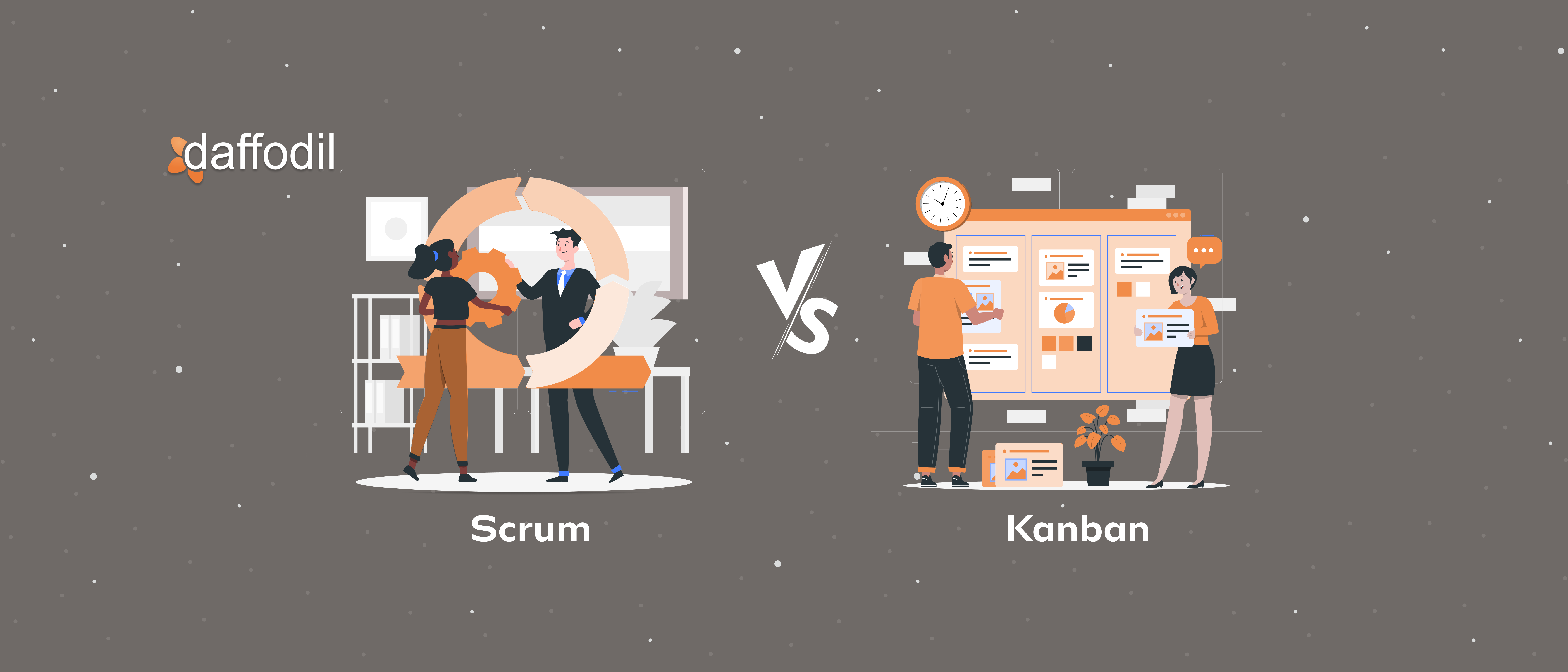
The idea of adopting an iterative development approach has been gaining grounds in the software industry. Agile methodology for project management, which was introduced back in 2001 has transformed the way software development companies deliver the product throughput. The Kanban Vs Scrum tilt has been going on for quite a time now. Here are the key differentiators that hold them apart.
Agile is a set of goals, principles, and practices that uncovers better way of developing a software. Agile methodology favors:
- Individuals and interactions over processes and tools
- Working software over comprehensive documentation
- Customer collaboration over contract negotiation
- Responding to change over following a plan
These values and principles espoused from Agile were underpinned into some of the Agile software development frameworks, such as Kanban, Scrum, Lean, XP.
In the later segment, we will understand two of the most popular Agile frameworks to acknowledge their benefits in a software development cycle. Kanban Vs Scrum; let’s start the comparison.
Scrum: A Structured Agile Approach
Scrum is an iterative and incremental approach to agile software development. In Scrum methodology, a Sprint is the basic unit of development. Each sprint starts with a meeting, wherein tasks for a sprint are identified, along with an estimated time to commit the sprint goal. A sprint ends with a review or a retrospective session, where the progress for defined tasks are reviewed and lessons for the next sprint are identified. At the end of each sprint, a finished portion of a product is created by the team.
In an Agile practice for software development, each iteration involves a team working on a full development cycle-involving planning, requirement analysis, design, coding, unit testing, and acceptance testing. If in a scrum sprint, all of the software development phases (right from requirement understanding to acceptance testing) are performed, the scrum sprint can be considered to be corresponding to Agile iterations.
There are 6 types of meetings in scrum:
- Daily Scrum / Standup
- Backlog grooming: storyline
- Scrum of Scrums
- Sprint Planning meeting
- Sprint review meeting
- Sprint retrospective
Scrum Cadence:
Scrum sprints generally have a time span of two to four weeks, with a clear start and finish dates. The short time frames ensure that complex tasks are split into short stories, enabling teams to learn fast and deliver expected outcomes to maintain project agility. Sprints are punctuated by ‘Inspect and Adapt’ ceremonies where the sprint tasks are reviewed through daily scrum (standup) meeting.
Core Roles:
a. Scrum Master,
b. Product Owner,
c. Development Team
Ancillary Role: These roles in Scrum teams don’t have a formal role and generally have infrequent involvement in the Scrum procession but nonetheless, they must be taken into account. viz. Stakeholders, Managers.
Release Methodology:
At the end of each review, the team reviews the increment (the end-product of a sprint) through a demo and either approves the release or declines it. A sprint should end with a shippable increment.
Key Metrics:
Velocity is the central metric to measure a scrum success. Velocity, which is counted through Story Points guides future sprint commitments or how much work the scrum team commits to. Story points rate the relative effort of work in a Fibonacci-like format: 0, 0.5, 1, 2, 3, 5, 8, 13, 20, 40, 100, instead of days, dates, or hours.
Kanban: A Continuous Improvement Approach
Unlike Scrum, Kanban is not a software development methodology. Instead of defining a roadmap for development, it allows visualizing and improving the ongoing tasks.
The Kanban approach to streamline development uses Kanban Board, which helps to visualize tasks, limit work-in-progress, and maximize efficiency or manage flow of development. The Kanban board use cards, columns, commitment, and delivery points to keep the team members informed about the work progress, so that teams commit to right amount of work and get it done.
5 major elements of a Kanban Board includes:
1. Visual Signals: Stickies, tickets, and other visual cards are an important part of a Kanban board. The Kanban teams write one user story on each card, which gives all team members an idea that about what the team is currently working on.
2. Columns: Each column on a Kanban board represents a specific activity, which all together compose a workflow. These cards flow through a workflow, which can be as simple as a “To-Do”, “In Progress”, “Complete” or could be complex as well.
3. Work in Progress (WIP) Limits: WIP limits are the maximum number of cards that can be moved to a column at a given time.
4. Commitment Point: The backlog is the place where the teammates put their ideas for project and usually pull the tasks from. The commitment point is the moment when an idea is picked by the team and either an individual or more starts working on it.
5. Delivery Point: The delivery point marks the end of Kanban workflow. The goal of a team is to move cards from commitment point to the delivery time, as fast as possible. Usually, the delivery point is, when the product is delivered to the customer.
Kanban Cadence:
Kanban is based on continuous workflow structure, wherein the team picks and prioritizes tasks according to expected lead time (from commitment to delivery point), complexity, availability of a team member etc.
Roles:
The entire team involved in software application development owns the Kanban board. There is no Kanban Master involved (like the Scrum Master in Scrum) to ensure that things move from one stage to another smoothly. Instead, the team is responsible to collaborate and finish the tasks listed on board.
Release Methodology:
There is no predefined time to complete and deliver a task. At any point, if a task is completed, it can be released, without having to wait for present release milestone.
Key Metrics:
Cycle Time: This is the average time taken to move a task from start to finish line. Continuous improvement in this time means increased team efficiency.
Cumulative Flow Diagram (CFD): This is an analytical tool that helps Kanban team to understand the number of work items to be added in each state.
Kanban Vs Scrum: Key Differentiators
let's delve deeper into the key differentiators between Kanban and Scrum methodologies:
1) Approach to Planning
Kanban: Kanban doesn’t prescribe specific planning intervals. Work is continuously pulled from the backlog as capacity allows. There are no set time frames, allowing for real-time adjustments based on workflow and demand.
Scrum: Scrum operates in fixed-length iterations (sprints). Teams commit to delivering a set of tasks within the sprint duration, which is usually 2-4 weeks. Planning occurs before each sprint, providing a structured timeline.
2) Roles and Structure
Kanban: Kanban is more fluid in roles. It doesn’t define specific roles apart from team members. The focus is on collaboration and ensuring tasks flow smoothly through stages, allowing team members to pick up work based on expertise and availability.
Scrum: Scrum has defined roles: Scrum Master, Product Owner, and Development Team. The Scrum Master facilitates the Scrum process, the Product Owner sets priorities and represents stakeholders, while the Development Team executes the work.
3) Work in Progress (WIP) Limits
Kanban: Kanban uses WIP limits to manage the number of tasks in progress at any given time. WIP limits prevent overloading the team and ensure a smooth flow of work items through the process.
Scrum: Scrum does not have explicit WIP limits within sprints. Instead, the focus is on completing the committed tasks within the sprint duration, ensuring a concentrated effort on a defined set of work.
4) Change Management
Kanban: Kanban allows changes at any point in the process. It accommodates shifting priorities and urgent tasks seamlessly, ensuring adaptability to evolving requirements.
Scrum: Scrum restricts changes during sprints to maintain focus and stability. Changes outside of the sprint are discouraged to provide a consistent, uninterrupted work environment.
5) Visualization and Metrics
Kanban: Kanban heavily relies on visual management through Kanban boards. It uses metrics like lead time and cycle time to analyze and improve the flow of work.
Scrum: While Scrum also uses visual boards (like task boards or burndown charts), its primary metrics include velocity (amount of work completed in a sprint) and burndown (remaining work).
Kanban Vs Scrum: Which Agile Framework to Choose?
Use Kanban When:
1) When tasks have diverse priorities and sizes, making it hard to plan in advance.
2) When work arrives steadily, and you want a continuous, uninterrupted workflow.
3) When you need the freedom to adapt to changing priorities and requirements.
4) When a visual representation of tasks moving through stages can improve efficiency.
5) When you prefer no fixed time constraints, allowing tasks to be completed at their own pace.
For example: Let's consider a marketing team that is responsible for various tasks like social media posts, email campaigns, and website updates. The team often faces changing priorities based on customer feedback and market trends. In this scenario, using Kanban would be beneficial. The team can visualize their tasks on a Kanban board, akin to digital sticky notes on a virtual wall. New tasks are added as cards, and team members move them across stages like 'To-Do,' 'In Progress,' and 'Completed.' This visual approach helps them handle a continuous flow of tasks, adapting to changes as they occur.
Use Scrum When:
1) When stakeholders need a clear schedule for feature releases.
2) When your team benefits from structured, time-boxed work cycles.
3) When consistent communication and collaboration among team members are crucial.
4) When you want to focus on delivering incremental progress and gathering feedback regularly.
5) When tasks need a clear commitment from the team within fixed timeframes.
Remember, the choice between Kanban and Scrum depends on the nature of your projects, your team's working style, and the level of structure and predictability you require.
Example: Now, consider a situation where the marketing team is launching a new product campaign. They need a structured approach to meet specific deadlines and milestones. In this case, Scrum is valuable. The team plans their work in fixed-length sprints, let's say two weeks. At the beginning of each sprint, they decide what tasks they can complete. Daily stand-up meetings keep everyone informed about progress and challenges. After the sprint, they conduct a review, showcasing what they've accomplished, and a retrospective, where they discuss what went well and what could be improved. This iterative approach ensures the team steadily progresses toward their campaign goals with each sprint.
In summary, for a marketing team dealing with evolving tasks, Kanban offers a flexible, visual way to manage work. For a team with specific campaign deadlines and a need for structured progress, Scrum provides a well-defined, iterative framework for achieving goals. The choice depends on the team's workflow and project requirements.







